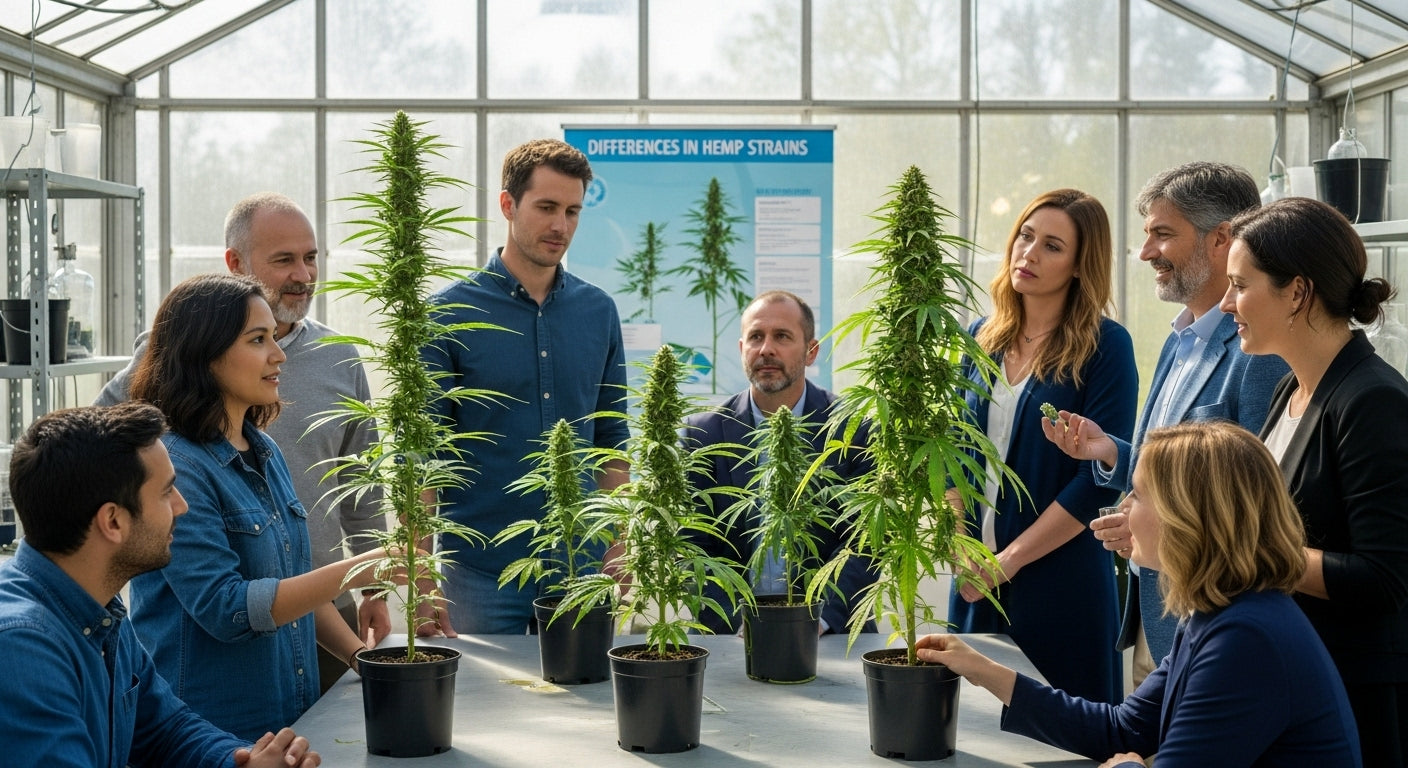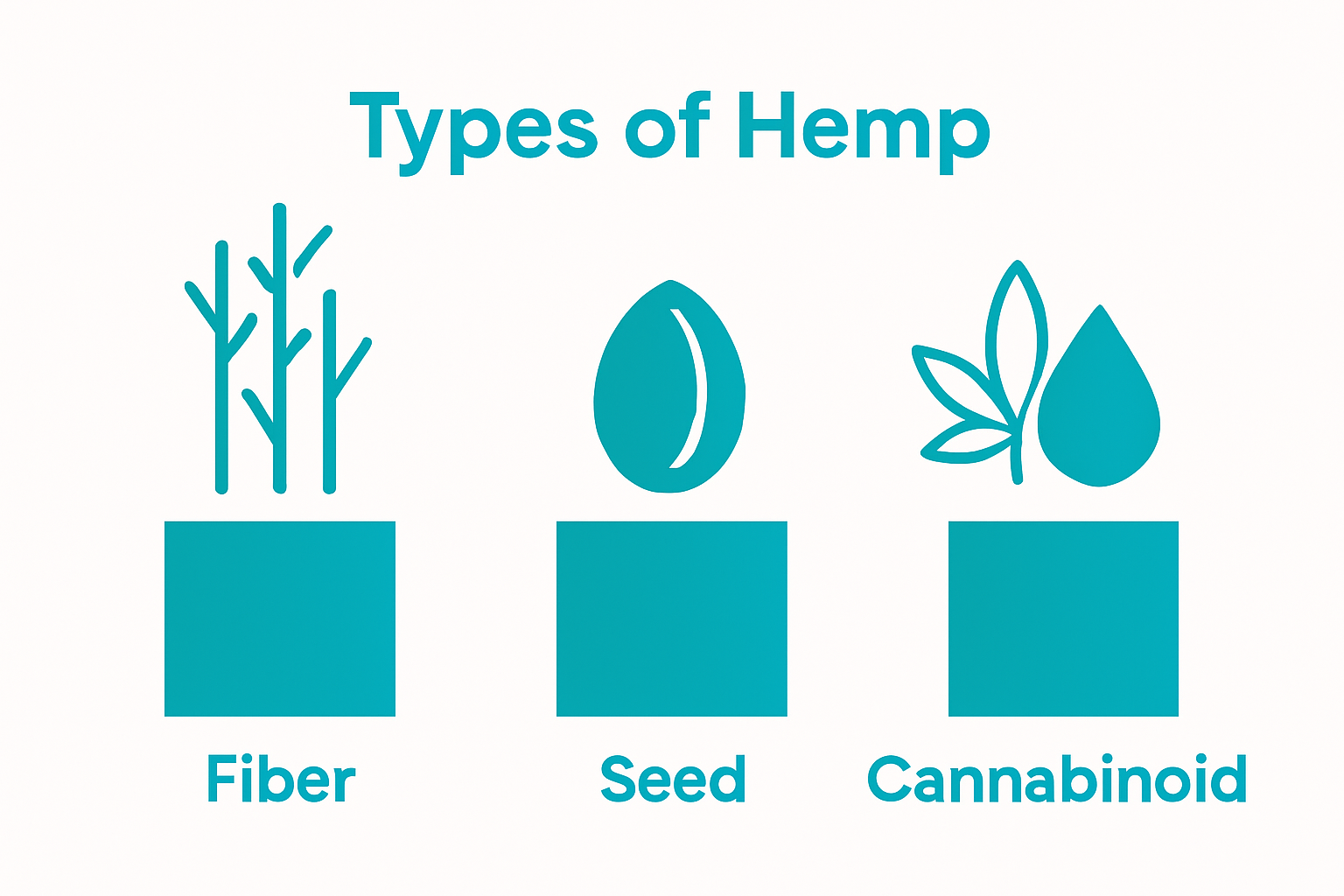

Understanding the Differences in Hemp Strains
Hemp strains might sound like a niche topic, but they shape everything from sustainable textiles to wellness supplements on store shelves. Here is what most people miss. Hemp legally must contain less than 0.3 percent THC to avoid being classified as marijuana, a tiny number with massive consequences for farmers, businesses, and anyone using hemp products. What often surprises newcomers is how diverse and specialized these strains really are, each with its own genetic blueprint and completely different uses.
Table of Contents
- What Are Hemp Strains And Their Varieties?
- Why Understanding Hemp Strains Matters For Consumers
- How Hemp Strains Affect Therapeutic Uses
- Key Characteristics That Differentiate Hemp Strains
- Real-World Implications Of Choosing Different Hemp Strains
Quick Summary
| Takeaway | Explanation |
|---|---|
| Choose the right hemp strain for specific needs | Different strains provide varied qualities and effects tailored to wellness and industrial applications. |
| Understand strain genetic profiles | Genetic differences influence plant traits, cannabinoid content, and adaptability, impacting user experience. |
| Select products aligned with quality and potency | Knowing strain differences allows consumers to identify the most effective hemp products for their goals. |
| Recognize legal implications of strain selection | Strains exceeding THC limits may face legal challenges; awareness is crucial for compliance. |
| Educate on health benefits tied to strains | Specific cannabinoid profiles can yield distinct therapeutic effects, enhancing wellness strategy planning. |
What Are Hemp Strains and Their Varieties?
Hemp strains represent the diverse genetic profiles of cannabis plants specifically cultivated for various purposes beyond recreational use. These specialized varieties are meticulously developed to produce specific characteristics, ranging from industrial fiber production to cannabinoid content. Understanding the nuanced world of hemp strains reveals a complex agricultural and botanical landscape.
Botanical Classification and Origins
Hemp belongs to the Cannabis sativa L. species, with multiple varieties distinguished by their genetic makeup and intended use. Botanically, hemp strains are classified into three primary categories:
- Fiber Hemp Strains: Tall plants with dense stalks optimized for textile and industrial material production
- Seed Hemp Strains: Focus on generating high-quality seeds rich in nutritional value
- Cannabinoid Hemp Strains: Bred specifically for extracting compounds like CBD with minimal THC content
Genetic Diversity and Purpose
Unlike popular misconceptions, hemp strains are not uniform. Each variety is carefully engineered through selective breeding to emphasize specific traits. These genetic differences impact critical aspects such as plant height, cannabinoid profile, growth cycle, and environmental adaptability. Research from Purdue University highlights how strategic breeding enables farmers and researchers to develop strains meeting precise industrial, agricultural, and wellness requirements.
By understanding the intricate differences in hemp strains, consumers and professionals can make informed choices about cultivation, extraction, and application across various industries including textiles, nutrition, and natural wellness.
To help clarify the main categories of hemp strains and their specific characteristics, the following table summarizes each type along with its primary use and distinguishing features.
| Hemp Strain Category | Primary Use | Key Characteristics |
|---|---|---|
| Fiber Hemp Strains | Textile and industrial materials | Tall plants, dense stalks, high fiber yield |
| Seed Hemp Strains | Nutritional seed production | Shorter plants, high-quality seeds, rich in nutrients |
| Cannabinoid Hemp Strains | Wellness and cannabinoid extraction | Bred for high CBD, minimal THC, specific cannabinoid profile |
| Dual Use Varieties | Fiber and seed combined | Balanced structure for both seed and fiber production |
Why Understanding Hemp Strains Matters for Consumers
Consumers navigating the complex world of hemp products need a comprehensive understanding of strain differences to make informed purchasing decisions. Learn more about CBD strain selection as we explore why strain knowledge is crucial for quality, efficacy, and personal wellness goals.
Quality and Potency Considerations
Hemp strains are not created equal. Each variety offers unique characteristics that directly impact product quality and potential therapeutic benefits. Understanding strain differences allows consumers to:
- Select products tailored to specific wellness needs
- Identify strains with optimal cannabinoid profiles
- Avoid potential ineffective or inappropriate hemp products
Health and Wellness Implications
According to research from the Alabama Cooperative Extension System, hemp contains less than 0.3% THC and offers diverse applications across health and wellness sectors. Different strains can provide varying effects, from relaxation to potential stress relief, making strain selection a critical component of personalized wellness strategies.
Moreover, consumers benefit from understanding hemp strain diversity by recognizing how genetic variations influence product characteristics. This knowledge empowers individuals to make educated choices about hemp-derived products, ensuring they select options most aligned with their personal health objectives and lifestyle requirements.

How Hemp Strains Affect Therapeutic Uses
The therapeutic potential of hemp varies dramatically across different strains, making strain selection a critical factor in wellness applications. Explore our comprehensive guide to cannabis strains to understand how specific genetic profiles influence potential health benefits.
Cannabinoid Profile Variations
Each hemp strain contains a unique combination of cannabinoids that determines its potential therapeutic effects. These molecular differences can significantly impact how the plant interacts with the human endocannabinoid system.
Key cannabinoid variations include:
- CBD Concentration: Directly influences potential stress and inflammation management
- Minor Cannabinoid Ratios: Impacts overall therapeutic potential
- Terpene Composition: Affects absorption and potential neurological interactions
Therapeutic Potential Research
According to groundbreaking research published in scientific journals, hemp strains exhibit remarkable diversity in their phytochemical profiles. Some strains demonstrate significant anti-inflammatory properties, with extracts showing potential to decrease pro-inflammatory responses and increase cellular viability.
The nuanced differences between hemp strains mean that not all products will deliver identical wellness outcomes. Consumers must recognize that strain-specific characteristics play a crucial role in determining potential therapeutic applications, ranging from stress relief to potential inflammation management. Understanding these subtle genetic variations empowers individuals to make more informed choices about their hemp-derived wellness products.
This table compares key therapeutic components across different hemp strains, outlining how variations in cannabinoid and terpene content influence potential wellness outcomes.
| Therapeutic Component | Variation Across Strains | Impact on Wellness |
|---|---|---|
| CBD Concentration | Low to very high | Affects potential for stress and inflammation relief |
| Minor Cannabinoid Ratios | Varies significantly | Alters overall therapeutic potential |
| Terpene Composition | Distinct profile per strain | Influences absorption and neurological interactions |
| THC Content | Always below 0.3% (by law) | Essential for legality and psychoactive risk |
Key Characteristics That Differentiate Hemp Strains
Hemp strains represent complex botanical variations with unique genetic profiles that distinguish their physical and chemical characteristics. Check out our comprehensive guide to CBD regulations to understand how these differences impact product development and legal compliance.
Physical Morphological Differences
According to research from Rutgers NJAES, hemp strains can be categorized into distinct types based on their physical characteristics and primary usage:

- Grain Varieties: Shorter plants with high protein and fatty acid content
- Fiber Varieties: Taller plants producing long fibers for textile manufacturing
- Dual Use Varieties: Capable of producing both fiber and seed
- Cannabinoid Varieties: Focused on high CBD content with minimal THC levels
Chemical and Genetic Composition
The fundamental differences between hemp strains extend beyond physical appearance into their complex chemical and genetic makeup. Each strain possesses a unique combination of cannabinoids, terpenes, and other phytochemicals that determine its potential applications and therapeutic properties.
Genetic variations influence not just the plant’s physical structure but also its biochemical potential. Researchers and cultivators meticulously select and breed strains to enhance specific characteristics, whether for industrial applications, nutritional value, or potential wellness benefits. Understanding these nuanced differences allows consumers and professionals to make informed decisions about hemp-derived products and their potential uses.
Real-World Implications of Choosing Different Hemp Strains
Choosing the right hemp strain involves more than understanding botanical characteristics. Check our guide on understanding cannabis strain varieties to explore the nuanced world of hemp selection and its potential consequences.
Legal and Compliance Considerations
Research from the National Institute of Justice reveals critical insights into the complex landscape of hemp strain selection. Key legal implications include:
- THC Threshold Risks: Strains exceeding 0.3% THC can be legally classified as marijuana
- Mislabeling Consequences: Inaccurate product labeling can lead to unintended legal complications
- Regulatory Compliance: Strain selection directly impacts product legality and marketability
Economic and Quality Control Challenges
Genetic variability among hemp strains presents significant challenges for producers and consumers. A groundbreaking study in Frontiers of Genetics demonstrated that even commercially available high-CBD hemp accessions exhibit substantial genetic and chemical inconsistencies. This variability means that seemingly identical strains can produce dramatically different cannabinoid profiles, impacting product effectiveness and economic value.
Understanding these real-world implications empowers consumers and producers to make informed decisions. Careful strain selection becomes crucial not just for achieving desired effects, but for navigating complex legal, economic, and quality control landscapes. The right strain can mean the difference between a compliant, high-quality product and a potential legal or economic liability.
Discover the Best Hemp Strains for Your Wellness Journey
Navigating the world of hemp strains can feel overwhelming, especially when you want reliable quality and proven benefits. The article just explored how genetic diversity, cannabinoid profiles, and legal compliance are crucial for a safe and effective experience. Many readers struggle with identifying strains that deliver genuine stress relief without unwanted THC, or worry about mislabeling and chemical inconsistencies in the hemp market.

Ready to experience premium hemp smokes that make choosing the right strain simple and safe? At Full Moons Club, our herbal alternatives are crafted with organic U.S.-grown hemp, rich in CBD and blended for purity, relaxation, and peace of mind. Each smoke contains 0 percent THC and uses biodegradable materials — so you get all the benefits with no compromises. Visit our homepage now to elevate your smoking ritual with transparency and quality you can trust. Secure your healthier, tobacco-free alternative today and feel the difference hemp strains can make.
Frequently Asked Questions
What are the main types of hemp strains?
Hemp strains are primarily categorized into three main types: fiber hemp strains, seed hemp strains, and cannabinoid hemp strains. Each type is cultivated for specific uses, such as industrial fiber, high-quality seeds, or cannabinoid extraction like CBD.
How do different hemp strains affect therapeutic applications?
Different hemp strains possess unique cannabinoid profiles, which significantly influence their therapeutic effects. Strains can vary in CBD concentration, minor cannabinoid ratios, and terpene composition—all of which can impact wellness outcomes such as stress relief and inflammation management.
Why is it important to understand the differences in hemp strains for consumers?
Understanding the differences in hemp strains allows consumers to make informed choices when selecting products. Each strain offers unique qualities that affect product quality, efficacy, and alignment with personal wellness goals, ensuring consumers choose options best suited to their needs.
How can genetic variations in hemp strains influence product quality?
Genetic variations among hemp strains lead to differences in physical characteristics and chemical composition, such as cannabinoid and terpene profiles. These variations can impact product effectiveness and quality, making strain selection crucial for achieving desired results in health and wellness applications.

